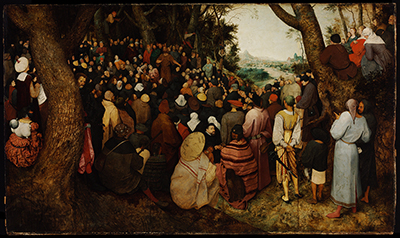This painting by Peter Bruegel the Elder depicts St John the Baptist enveloped by a crowd of people who listen to his words intently
The Sermon (Preaching) of Saint John the Baptist may not have the same artistic respect as more famous Bruegel paintings such as Hunters in the Snow and The Tower of Babel, but it still perfectly summarises the style of a man who devoted his career to capturing scenes of the poor in his local environment. All of the available evidence points to this painting being the one from Bruegel found in the collection of the Infanta Isabella Clara Eugenia, who was the Governor of the Netherlands in the 17th century. The documented descriptions of the piece match the composition and style of this painting.
Despite growing up in towns, this artist seemed to truly understand and be interested in the lives of farm peasants and others around that community. Bruegel liked to paint scenarios of cohesion and happiness, whilst others would depict the poorer elements of society in a far more negative way. The art world over the last few centuries has opened up widely, beyond what anyone might have imagined during Bruegel's time. At that point, though, portraits of the rich and famous plus religious scenes dominated the art world, making the style of Pieter Bruegel all the more unusual and brave.
The original painting measures 161cm wide by 95cm tall and can be found in the Museum of Fine Arts in Budapest (Szépművészeti Múzeum), Hungary. This prestigious museum has one of the finest art collections in Eastern Europe, also boasting paintings by the likes of El Greco, Lucas Cranach the Elder, Giorgione, Correggio, Titian, Tintoretto, Albrecht Durer, Peter Paul Rubens, Diego Velazquez and Goya.




